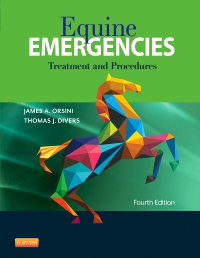
Equine Emergencies - Elsevier eBook on VitalSource, 4th Edition
Elsevier eBook on VitalSource

Ideal for use in the clinic and in the field, Equine Emergencies: Treatment and Procedures, 4th Edition, offers practical step-by-step guidelines for effectively managing a wide range of emergency situations. Thoroughly updated content keeps your students informed of the latest advances in horse care in a portable, convenient format.
Newer Edition Available
Equine Emergencies - Elsevier eBook on VitalSource
-
- What to Do and What Not to Do boxes guide your students through the step-by-step treatment of an emergency and draw their attention to important steps to take and those to avoid.
- Essential examination, diagnostic, and treatment information for each body system is presented in a logical format so your students can quickly find answers during equine emergencies.
- High-quality photographs and illustrations visually clarify key concepts and guide your students through procedures step by step.
- NEW! Chapter on emergency diagnostic procedures keeps your students up-to-date on all the tests needed to determine the most effective treatment.
- NEW! Chapter on gene testing provides information on which gene tests and labs should be performed.
- NEW! Chapter on biopsy techniques highlights the different instruments available, endoscopic and laparoscopic techniques, as well as how to perform a pleuritis examination.
- NEW! Chapters on feeding and starvation and flood injury supply the latest guidelines for nutrition, disaster medicine, and snake bites/envenomation.
- NEW! Chapter on laboratory submission offers the latest information on tests, laboratory charts, guidelines for making an appropriate submission, and blood drawing.
- NEW! Chapter covering bacterial and viral diseases arms your students with critical information on diagnostic labs, collection, submission, and interpretation.
-
- NEW! Chapter covering bacterial and viral diseases arms you with critical information on diagnostic labs, collection, submission, and interpretation.
- NEW! Chapter on emergency diagnostic procedures keeps you up-to-date on all the tests needed to determine the most effective treatment.
- NEW! Chapter on gene testing provides information on which gene tests and labs should be performed.
- NEW! Chapter on biopsy techniques highlights the different instruments available, endoscopic and laparoscopic techniques, as well as how to perform a pleuritis examination.
- NEW! Chapter on laboratory submission offers the latest information on tests, laboratory charts, guidelines for making an appropriate submission, and blood drawing.
- NEW! Chapters on feeding and starvation and flood injury supply the latest guidelines for nutrition, disaster medicine, and snake bites/envenomation.
-
PART 1: EMERGENCY PROCEDURES AND DIAGNOSTICS
Section I: Important Diagnostic and Therapeutic Procedures for Emergency Care
1. Blood Collection
2. Medication Administration and Alternative Methods of Drug Administration
3. Intravenous Catheter Selection, Sites for Placement and Maintenance
4. Venous Cutdown
5. Intraosseous and Regional Perfusion
6. Biopsy Techniques
7. Hyperbaric Oxygen Indications in Emergencies
8. Alternative Therapies in Emergencies: Acupuncture
Section II: Emergency Imaging, Endoscopy, Laboratory Diagnostics and Monitoring
9. Bacterial, Fungal and Viral Diagnostic Samples
10. Critical and Emergency Care Monitoring Techniques
11. Cytology
12. Emergency Diagnostic Endoscopy
13. Gene Testing
14. Imaging Techniques and Indications for the Emergency Patient
15. Laboratory Tests and Point of Care Diagnostics
PART 2: EMERGENCY EXAMINATION AND MANAGEMENT OF ORGAN SYSTEMS
Section I: Body and Organ Systems
16. Blood Coagulation Disorders
17. Cardiovascular System
18. Gastrointestinal System
19. Integumentary System
20. Liver Failure, Anemia and Blood Transfusion
21. Musculoskeletal System
22. Nervous System
23. Ophthalmology
24. Reproduction System
25. Respiratory System
26. Urinary System
Section II: Pregnancy, Perinatal/Neonatal Period
27. Monitoring the Pregnant Mare
28. Emergency Foaling
29. Foal Resuscitation
30. Perinatology
31. Neonatology
Section III: Shock, Temperature Related Problems, Systemic Inflammatory Response Syndrome and Muti-Organ Dysfunction Syndrome
32. Shock, Systemic Inflammatory Response Syndrome (SIRS), Multi-Organ Dysfunction Syndrome (MODS)
33. Temperature Related Problems: Hypothermia and Hyperthermia
PART 3: TOXICOLOGY
34. Toxicology
PART 4: SPECIAL PROBLEM EMERGENCIES
Section I: Special Problems
35. Burns, Acute Soft Tissue Swellings. Pigeon Fever
36. Caring for the Down Horse
37. Disaster Medicine
38. Diseases Unique to Donkeys and Miniature Horses
39. Diseases Unique to Draft Horses
40. Emergency Diseases Unique to Countries Outside the Continental United States
41. Flood Injury
42. Foot Injuries
43. Laminitis
44. Orthopedic Emergencies of the Racing Athlete
45. Snake Envenomination
46. Thoracic Trauma
Section II: Anesthesia
47. Anesthesia for Out-of-Hospital Emergencies
48. Euthanasia/Humane Destruction
49. Pain Management
Section III: Nutrition
50. Approach to the Feed and Starvation Emergency
51. Nutritional Guidelines for the Injured, Hospitalized and Postsurgical Patient
Section IV: Biosecurity
52. Contagious and Zoonotic Diseases
53. Standard Precautions and Infectious Disease Management
APPENDICES
1: Commonly Used Formulas and Calculations in Emergency Care
2: Important Equivalents and Conversions for Clinical Practice
3: Miscellaneous Charts and Tables Useful in Clinical Practice
4: Reference Values
5: Clinical Pharmacology and Emergency Drug Facts
A. Emergency Drugs, Recommended Dosages and Adverse Drug Events
B. Drugs for Specific Emergencies, Protocols and Clinical Situations
- Antibiotics – Concentration Dependent vs. Time Dependent Drugs
- Anesthetic Induction
- Cardio-Respiratory Resuscitation
- Cardiac Arrhythmia Drugs and Protocols
- Pharmacologic Adjuncts to Intubation
- Physical and Chemical Restraint
- Pressors
- Prokinetics
- Seizure Control
- Sepsis
- Shock
C. Adverse Drug Events and Management
D. Clinical Signs and Overdose Response of Commonly Used Medications and
Recommended Treatments
INDEX


 as described in our
as described in our 